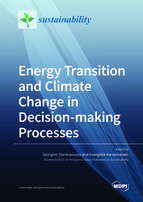Energy Transition and Climate Change in Decision-making Processes
A special issue of Sustainability (ISSN 2071-1050). This special issue belongs to the section "Energy Sustainability".
Deadline for manuscript submissions: closed (30 September 2021) | Viewed by 48053
Special Issue Editors
Interests: environmental communication; environmental policy; public relations; forest extension
Special Issues, Collections and Topics in MDPI journals
Interests: environmental communication; environmental policy; environmental awareness
Special Issues, Collections and Topics in MDPI journals
Special Issue Information
Dear Colleagues,
There has recently been growing concern about the climate, and numerous voices have stressed that, in order to overcome the climate crisis, the transition to a low-carbon society is the most reasonable path to follow. In this type of society, individuals would be characterized by mindful efforts to drastically decrease carbon and greenhouse gas emissions, and promote benign energy sources. Nevertheless, in order to facilitate this transition, it is deemed necessary that the relevant decision-making processes integrate a social perspective. This is because the public can often affect actions aimed at realizing this transition. To avoid complications and reinforce the transition efforts, public attitudes towards energy transition and climate change must be studied and analysed. In other words, the knowledge of public attitudes can be used as a roadmap to design effective decision-making processes or to enhance the existing ones.
Against this background, we invite scholars and practitioners conducting research in the areas of climate change and energy transition to submit their work to this Special Issue. The Issue will include, but will not be limited to, the following topics. We welcome researchers who carry out social, economic, and technological studies to contribute to this Issue in order to establish a valuable source of information that can be used to enhance decision-making processes, which, in turn, can turn the energy transition into reality. In specific, we welcome research works that measure environmental awareness among various social groups in developed and developing countries. In addition, we are interested in studies on public responses to renewable and non-renewable energy sources. We would also like to include research works analysing the economic impacts of the energy transition and works evaluating the technological performance of renewable systems, as well as studies assessing different models of environmental policy. Original papers related to the above topics and dealing, generally, with methodologies, numerical and experimental investigations, and case-studies addressing energy transition and climate change are welcome. Finally, we encourage the authors who will submit their papers to the Special Issue to discuss the ways in which their findings could be used to effectively improve existing decision-making processes or establish new forms of processes.
Prof. Dr. Georgios TsantopoulosMrs. Evangelia Karasmanaki
Guest Editors
References:
- Adua, L., York, R., & Schuelke-Leech, B. A. (2016). The human dimensions of climate change: A micro-level assessment of views from the ecological modernization, political economy and human ecology perspectives. Social Science Research, 56, 26-43.
- Brisbois, M. C. (2019). Powershifts: A framework for assessing the growing impact of decentralized ownership of energy transitions on political decision-making. Energy Research & Social Science, 50, 151-161.
- Dittrich, R., Wreford, A., & Moran, D. (2016). A survey of decision-making approaches for climate change adaptation: Are robust methods the way forward?. Ecological Economics, 122, 79-89.
- Hazboun, S. O., Briscoe, M., Givens, J., & Krannich, R. (2019). Keep quiet on climate: Assessing public response to seven renewable energy frames in the Western United States. Energy Research & Social Science, 57, 101243.
- Ioannou, K., Tsantopoulos, G., & Arabatzis, G. (2019). A Decision Support System methodology for selecting wind farm installation locations using AHP and TOPSIS: Case study in Eastern Macedonia and Thrace region, Greece. Energy Policy, 132, 232-246.
- Karasmanaki, E., & Tsantopoulos, G. (2019). Exploring future scientists' awareness about and attitudes towards renewable energy sources. Energy Policy, 131, 111-119.
- Kardooni, R., Yusoff, S. B., Kari, F. B., & Moeenizadeh, L. (2018). Public opinion on renewable energy technologies and climate change in Peninsular Malaysia. Renewable energy, 116, 659-668.
- Lefkeli, S., Manolas, E., Ioannou, K., & Tsantopoulos, G. (2018). Socio-cultural impact of energy saving: Studying the behaviour of elementary school students in Greece. Sustainability, 10(3), 737.
- McCormick, K., & Kautto, N. (2013). The bioeconomy in Europe: An overview. Sustainability, 5(6), 2589-2608.
Manuscript Submission Information
Manuscripts should be submitted online at www.mdpi.com by registering and logging in to this website. Once you are registered, click here to go to the submission form. Manuscripts can be submitted until the deadline. All submissions that pass pre-check are peer-reviewed. Accepted papers will be published continuously in the journal (as soon as accepted) and will be listed together on the special issue website. Research articles, review articles as well as short communications are invited. For planned papers, a title and short abstract (about 100 words) can be sent to the Editorial Office for announcement on this website.
Submitted manuscripts should not have been published previously, nor be under consideration for publication elsewhere (except conference proceedings papers). All manuscripts are thoroughly refereed through a single-blind peer-review process. A guide for authors and other relevant information for submission of manuscripts is available on the Instructions for Authors page. Sustainability is an international peer-reviewed open access semimonthly journal published by MDPI.
Please visit the Instructions for Authors page before submitting a manuscript. The Article Processing Charge (APC) for publication in this open access journal is 2400 CHF (Swiss Francs). Submitted papers should be well formatted and use good English. Authors may use MDPI's English editing service prior to publication or during author revisions.
Keywords
- Public opinion
- Climate change
- Energy transition
- Renewable energy sources
- Decision-making processes
- Environmental education
- Environmental communication
- Low-carbon society







